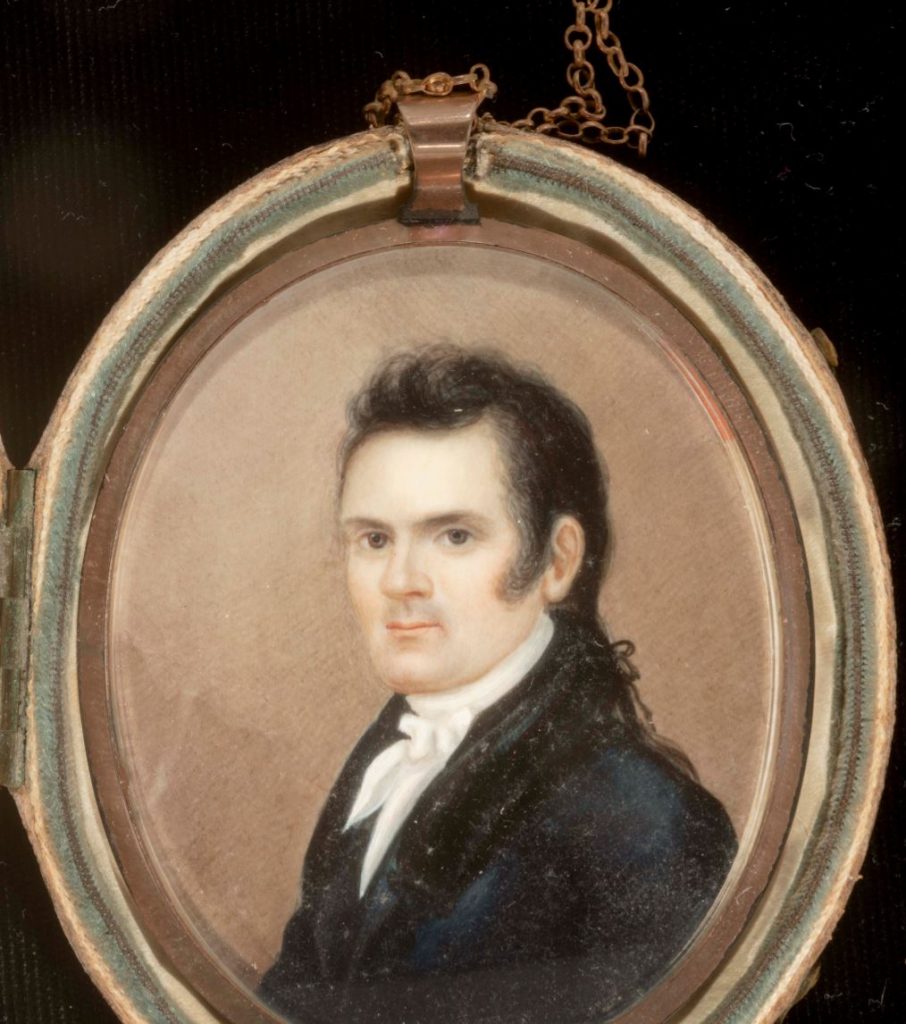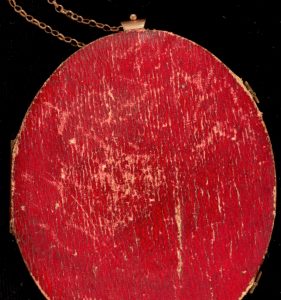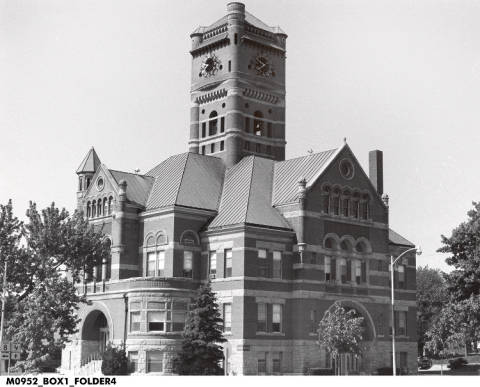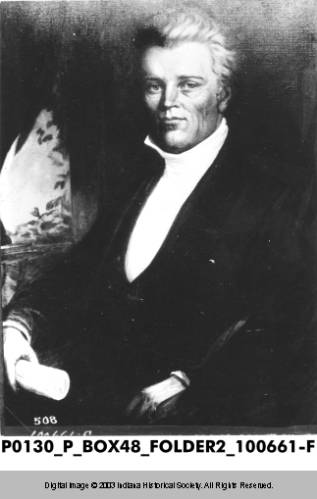
Plan your visit
My Favorite Things
June 16, 2020

Through my years of service in the library, archival and museum profession, I’ve fielded a plethora of questions from visitors, researchers and the media. Invariably, among the most frequent of queries asked of curators and collection managers by audiences focused on superlatives—oldest, biggest, best—is: “What is your favorite thing in the collection?”
The prompting of such an inquiry can throw its intended recipient into a “Sophie’s Choice” sort of scenario, and who could ever decide between their children or, on a more personal level for me, their cats? For history professionals, the dilemma encumbers likewise, and especially with the IHS gems entrusted to our care. When pressed for an answer, and before spiraling into an anguished torment that could sufficiently match Meryl Streep’s, I resort to my fallback response:
It’s the James Noble portrait miniature.

Documentary image of James Noble portrait miniature in its case. Indiana Historical Society, R0975
Physical description:
What is it? A hand painted oval portrait behind a glass overlay, a cobalt blue glass backing, set in an oval gold frame with gold loop at top, suspending long gold chain with barrel clasp; has accompanying wooden oval case, covered in red leather, with white satin lining, green velvet trim, and two hook and eye closures for fastening.

Documentary image of leather case exterior for miniature. Indiana Historical Society, R0975

Documentary image of cobalt blue glass verso of miniature. Indiana Historical Society, R0975
About the item:
This object dates from the founding years of Indiana’s youthful statehood. It is a treasured piece of artistry that represents, visually, James Noble—a key player in Indiana’s formative years of participation on the national political stage, and a contemporary of statesmen like Daniel Webster, Rufus King, Thomas Hart Benton and John C. Calhoun, and also of future presidents John Quincy Adams, Andrew Jackson, Martin Van Buren and William Henry Harrison.
Portrait miniatures were first developed in the 1520s and flourished in Europe. The art was exported to the American Colonies no later than the 1750s. Usually presented as intimate gifts, they often served as keepsakes of “hope and remembrance” rather than for mourning or memorializing. Documentation suggests the James Noble miniature dates from ca. 1820. A likely gift of the Hoosier senator to his Irish-born wife, Mary Lindsay Noble, the miniature has an inherent emotional component, illustrating invisibly the bond between husband and wife, between Midwest and East Coast, and, in its beauty, it offers a simple, yet refined element reflecting the migration of formal art and culture from a burgeoning civilization to the relatively untamed and yet rough hewn frontier. Perhaps most of all, it presents to viewers an evocative emotional tug at our heartstrings, where we can feel both the separation of and the bond between a man and his family.
How many times did Mary Lindsay Noble look at the miniature, longing to see her husband, to ask him questions, to seek his advice and counsel about family or business matters, or to simply imagine holding his hand? Thoughts drift back to John and Abigail Adams, less than 50 years earlier, similarly separated by the many miles between Braintree, Massachusetts and Philadelphia, writing their deepest thoughts to one another and coping with the geographical divide that kept them apart.
Sadly, we know very little of the painted image, the artist or when precisely the miniature was completed, adding a veil to its mystique. It was likely painted in Washington, D.C. and given as a keepsake to Mrs. Noble on one of her husband’s return trips to Indiana. There was a report in 1883 that the miniature was in the possession of a granddaughter, Mrs. Austin H. Brown. It came to the Indiana Historical Society in September 1944 as a gift of Cornelia Brown Edmiston (Mrs. Hugh Caldwell Edmiston, Jr.) of Short Hills, NJ. She was evidently a great-great granddaughter of the Nobles – the last to hold and admire this treasured historical image.

Some claim that Noble County, Indiana, founded in 1836, was named after Senator James Noble, while others claim the name was granted to honor his brother, Governor Noah Noble. Noble County Courthouse, completed in 1887, as it appeared in 1977.
Indiana Historical Society, M0952
About the subject:
Indiana’s first senator, James Noble, was born 16 December 1785, the eldest child of Thomas Noble of Clarke County, Virginia. Though cultivated a laborer and a ferryman, a lusty and ambitious young James had higher aspirations for self-improvement. Described as strong, industrious, independent and self-reliant—one might say a textbook “firstborn” child—Noble’s drive and leadership earned him a reputation as a successful orator and skilled trial lawyer whose eloquence could mesmerize a jury.
Grounded in the principles of freedom and serving people, Noble crafted a career that carried him from frontier Kentucky to backwoods Indiana to the budding new capitol of Indianapolis, then to Washington, D.C. What a distance he traveled in less than 20 years! Having come of age in Kentucky, where his family had migrated in 1795, the Virginia-born, self-educated Noble married, at the age of 17, in 1803, “to Mary Lindsay, of Newport,” while studying with a local lawyer there—a Mr. Southgate. Winning favor with his mentor, and then passing the bar, the restless Noble moved on to Indiana—a state not bound to slavery.
By 1809, Noble had started a family, establishing himself in Brookville, one of the few communities in the territory where a lawyer could excel and prosper. There, he became prosecuting attorney in 1810, then circuit judge of the eastern Indiana district. Known for his honesty, integrity, boldness, fearlessness and magnetic physical presence, Noble was on the fast track to success. He represented the citizenry in both Indiana’s territorial house and council (1813-15), then served as delegate to the constitutional convention (June 1816), whereupon he was elected to the first State house of representatives (August 1816).
Upon convening in November 1816, that body swiftly selected Noble for U.S. Senate. He served and was popularly elected as senator for three consecutive terms—nearly 15 years—and was the second highest ranking senator, by seniority, at the time of his death, 26 February 1831, in the nation’s capital.
A stalwart supporter of socioeconomic progress, democratic principles, steady national internal improvements, and the “American System” of Adams and Clay, Noble was fittingly eulogized by his peers, including fellow Hoosier, Senator William Hendricks, and interred at the Congressional Cemetery in Washington, D.C. It is doubtful the family could have attended the service in time. The widowed Mrs. Noble survived another five years and died in 1836 in Columbus, Indiana.
Some interesting Noble facts:
- James Noble was a ferry boat operator, lawyer, judge.
- He and his wife had six children.
- James Noble prosecuted at the historic 1824 Fall Creek Massacre trial—“the first case on record in America where a white man was hanged for killing an Indian.”
- Benjamin Sedgwick Noble was the name of two men; one a son of Noble and the other a much younger brother, both of whom served in the Indiana State House of Representatives in the years between 1829-1838.
- Senator Noble’s well-known brother, Noah, later served two terms as governor of Indiana.
- Noble County, Indiana is named for either Senator Noble or Governor Noble, depending on sources consulted.

Noble’s younger brother, Noah Noble (1794-1844) served as Indiana’s fifth governor, from 1831-1837.
Bass Photo Co. Collection, Indiana Historical Society
While the Indiana Historical Society’s collection policy limits its ability and commitment to collect large paintings or three-dimensional artifacts, the James Noble miniature acquisition of 76 years ago clearly represents a unique and exceptional source of visual documentation with a rich history, both in the collection and in its own right. It will forever be a revered piece.









